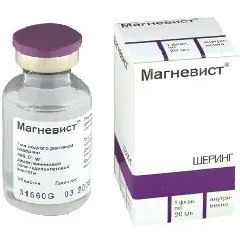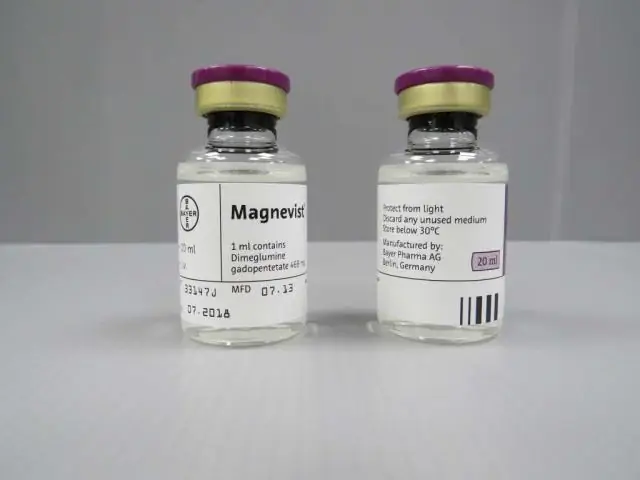- Author Rachel Wainwright [email protected].
- Public 2023-12-15 07:39.
- Last modified 2025-11-02 20:14.
Magnevist
Magnevist: instructions for use and reviews
- 1. Release form and composition
- 2. Pharmacological properties
- 3. Indications for use
- 4. Contraindications
- 5. Method of application and dosage
- 6. Side effects
- 7. Overdose
- 8. Special instructions
- 9. Application during pregnancy and lactation
- 10. Use in childhood
- 11. In case of impaired renal function
- 12. Drug interactions
- 13. Analogs
- 14. Terms and conditions of storage
- 15. Terms of dispensing from pharmacies
- 16. Reviews
- 17. Price in pharmacies
Latin name: Magnevist
ATX code: V08CA01
Active ingredient: gadopentetic acid (Gadopentetic acid)
Manufacturer: Bayer Pharma, AG (Bayer Pharma, AG) (Germany); Medsintez plant (Russia)
Description and photo update: 2018-27-11

Magnevist is a contrast diagnostic tool for magnetic resonance imaging (MRI).
Release form and composition
Magnevist is produced in the form of a solution for intravenous (iv) administration: a clear, colorless or almost colorless liquid, free of foreign particles (5, 10, 15, 20 or 30 ml each in a glass vial of hydrolytic class I, sealed with a rubber stopper and rolled in an aluminum cap; 10, 15 or 20 ml in a plastic or glass syringe, 1 syringe in a sealed PVC container; in a cardboard box 1, 5 or 10 bottles / containers and instructions for use of Magnevist).
1 ml of an aqueous solution contains:
- active substance: dimeglumine salt of gadopentetic acid - 469.01 mg, which corresponds to gadopentetate dimeglumine in an amount of 0.5 mmol [osmolality of the substance (Osm / kg H 2 O) at 37 ° C is 1.96; viscosity (mPa s) at 20 ° C - 4.9, at 37 ° C - 2.9; density (g / ml) at 20 ° C - 1.21, at 37 ° C - 1.195; pH - 7-7.9];
- additional components: pentetic acid (diethylenetriaminepentaacetic acid - DTPA), meglumine, water for injection.
Pharmacological properties
Pharmacodynamics
Magnevist is a paramagnetic contrast agent for MRI. The contrasting effect it demonstrates is due to the di-N-methylglucamine salt of gadopentetate, a complex of gadolinium with DTPA. When the appropriate scanning sequence is used (for example, the T 1 -weighted spin echo method) for proton magnetic resonance imaging, gadolinium ions shorten the spin-lattice relaxation time of atomic nuclei in a state of excitation, which leads to an increase in signal intensity and an increase in image contrast. certain tissues.
Dimeglumine gadopentetate does not have a tendency to bind to proteins and does not inhibit enzyme activity (including myocardial Na + -K + -ATPase). Magnevist does not activate the complement system and thus has a very low potential to induce the development of anaphylactoid reactions.
Pharmacokinetics
Dimeglumine gadopentetate is a compound with pronounced paramagnetic properties that significantly shortens the relaxation time even when used in low concentrations.
The pharmacokinetics of the active substance is similar to the pharmacokinetics of other biologically inert compounds with high hydrophilicity (including inulin or mannitol) and does not depend on its dose. After intravenous administration, the agent is quickly enough distributed in the extracellular space. When using gadopentetate dimeglumine at doses below 0.25 mmol / kg body weight (equivalent to Magnevist at a dose of 0.5 ml / kg), after a rapid distribution phase lasting several minutes, its blood concentration level decreases, the half-life (T 1/2) is approximately 90 minutes. After the introduction of the active substance at a dose of 0.1 mmol / kg (equivalent to Magnevist at a dose of 0.2 ml / kg) after 3 and 60 minutes, its plasma level in the blood is 0.6 and 0.24 mmol, respectively.
The drug does not cross the blood-testicular barrier or the intact blood-brain barrier (BBB); in a small amount penetrates the placental barrier and is rapidly excreted from the fetus.
The active substance is excreted unchanged by the kidneys by means of glomerular filtration, only a small part of the drug is exposed to extrarenal excretion. On average, after injection, after 6 and 24 hours, 83 and 91% of the administered dose are eliminated, respectively, less than 1% is excreted through the intestines in 5 days. With a body surface area of 1.73 m 2, the renal clearance of gadopentetate dimeglumine is approximately 120 ml / min.
Indications for use
Magnevist is used for MRI of the brain and spinal cord (cranial and spinal MRI) to enhance image contrast in the following studies:
- differential diagnosis in case of suspected neuroma of the auditory nerve, meningioma, tumors with infiltrative growth in nearby tissues (for example, glioma);
- detection of tumors, including small and poorly visualized tumors, tumor recurrence after surgery or radiation therapy, metastases;
- differential diagnosis of some rare tumors (ependymoma, hemangioblastoma, small pituitary adenomas);
- improved visualization of intracranial spread of extracerebral tumors.
Additional indications for the use of Magnevist during spinal MRI:
- differential diagnosis of extramedullary and intramedullary tumors;
- assessment of the prevalence of intramedullary tumors;
- establishing the size of solid tumors in the spinal cord.
When performing MRI of the whole body (including when examining the neck region, facial region of the skull, mammary glands in women, thoracic and abdominal cavities, pelvic organs, musculoskeletal system, obtaining an image of the vessels of the whole body) to enhance the contrast of the image, Magnevist is used for the following purposes:
- identification and / or establishment of the prevalence and boundaries of the inflammatory process, tumor, vascular damage;
- differential diagnosis of tumors and scar tissue after therapy;
- assessment of blood supply to normal and pathologically altered tissues;
- differential diagnosis of the structure of pathological changes;
- identification of recurrence of intervertebral disc prolapse after surgery;
- simultaneous semi-quantitative assessment of renal function and their visualization.
Contraindications
The drug is contraindicated for use with existing hypersensitivity to its components.
A contrast agent should be used with extreme caution in the following conditions / diseases:
- epilepsy;
- severe circulatory failure;
- bronchial asthma;
- a history of allergic reactions;
- pregnancy;
- severe renal impairment with creatinine clearance (CC) below 20 ml / min.
Magnevist, instructions for use: method and dosage
Magnevist is intended solely for intravenous administration. Immediately after injection of the drug, you can start an MRI study with contrast. The agent is not used for administration under the meninges.
In the range from 0.14 to 1.5 T, the recommended doses of the drug do not depend on the strength of the magnetic field.
It is required to collect Magnevist from a vial into a syringe or take a pre-filled syringe from a sealed container and release it from a protective cap immediately before administration. It is allowed to pierce the rubber stopper of the bottle with the solution no more than once. The remains of the contrast agent not used during the examination must be disposed of.
It is recommended to use a flexible catheter or cannula for intravenous administration of the solution. It is necessary to use the drug only in a hospital setting with equipment designed to provide emergency care in emergency situations, including the implementation of resuscitation measures. During MRI, it is necessary to observe the usual precautions for this method (patients should not have pacemakers, vascular clips made of ferromagnetic materials, etc.).
During the intravenous administration of the solution, the patient should be (if possible) in a horizontal position, and after the injection he should be under close medical supervision for at least 30 minutes.
In children over 2 years of age and adults, intravenous administration of the drug can be carried out manually or using an automatic injector. In children under 2 years of age, including newborns (up to 1 month), the solution must be administered exclusively by hand.
Patients with moderate kidney damage (CC is 30-60 ml / min) and children aged 1 to 12 months, the use of the drug should be limited to the introduction of a standard dose (0.1 mmol / kg), while repeated administration can be carried out no earlier than 7 days later.
For studies with the use of contrast enhancement in scanning, as a rule, T 1 -weighted sequences are used.
Recommended dosage regimen:
- cranial and spinal MRI: children (including newborns and infants), adolescents and adults are injected at 0.2 ml / kg; if after the study there is a suspicion of the presence of a lesion, for a more accurate diagnosis, it is allowed to carry out a second contrast study - 30 minutes after the first injection of the drug, it is re-injected at a dose of 0.2 / 0.4 ml / kg, followed by immediate MRI;
- Whole body MRI: adults and children over 2 years old are injected at 0.2 ml / kg, if the pathological formation is located in an area with a low degree of vascularization and / or with an insignificant extracellular space, in order to achieve an appropriate contrasting effect, it may be necessary to administer the drug at a dose of 0, 4 ml / kg, especially in the case of using short T 1 -weighted sequences when scanning.
The introduction of Magnevist at a dose of 0.6 ml / kg to adult patients can increase the reliability of diagnosis in many pathological lesions or recurrent tumors. For adults, the maximum single dose is 0.6 ml / kg, for children - 0.4 ml / kg.
For the purpose of vascular imaging, depending on the study site and the MRI technique used, adults can be prescribed a maximum single dose of 0.6 ml / kg.
Side effects
- cardiovascular system: rarely - drop in blood pressure, fainting, cyanosis, peripheral vasodilation, reflex tachycardia, arterial hypotension, arrhythmia, cardiac arrest;
- nervous system: sometimes - headaches, dizziness, paresthesia; rarely - drowsiness, asthenia, tremor, agitation (agitation), confusion, speech disorders, convulsions, coma;
- digestive system: sometimes - vomiting, nausea; rarely - hypersalivation, dry mouth, taste perversion, abdominal pain, diarrhea, increased activity of bilirubin and liver enzymes in the blood (transient);
- sensory organs: rarely - pain in the ears, pain in the eyes, lacrimation, impaired vision / hearing / smell;
- respiratory system: rarely - cough, shortness of breath, pulmonary edema, respiratory failure, respiratory arrest;
- dermatological reactions: rarely - itching, rash, skin redness (due to vasodilation), edema;
- urinary system: rarely - frequent urge to urinate, urinary incontinence; in patients with previous kidney damage - an increase in the concentration of creatinine in the blood and acute renal failure;
- allergic reactions: rarely - skin reactions (urticaria), conjunctivitis, sneezing, rhinitis, cough, bronchospasm, laryngospasm, laryngeal / pharyngeal edema, angioedema, arterial hypotension, shock;
- local reactions: rarely in case of extravasation - a feeling of warmth / cold, inflammation, local pain, edema, phlebitis, thrombophlebitis, tissue necrosis;
- general reactions: sometimes - headache, feeling of heat; rarely - increased sweating, malaise, chest / joint pain, back pain, fever, fainting;
- others: rarely - a transient increase in the level of iron in the blood serum.
Overdose
Symptoms of an overdose of gadopentetic acid may be manifestations of hyperosmoticity - an increase in pressure in the pulmonary artery, hypervolemia, increased urine output, dehydration.
This condition requires monitoring of renal function, especially in patients with renal insufficiency. Dimeglumine gadopentetate is excreted from the body by hemodialysis.
special instructions
Patient should refrain from eating two hours before the examination to reduce the risk of aspiration.
The introduction of gadopentetic acid can lead to the appearance of serious allergic reactions (including anaphylactic shock), most of which occur within 30 minutes after injection, however, in some cases, delayed responses may develop that occur several hours or days after the study.
Before prescribing the drug, it is necessary to carefully collect an allergic history of patients for the presence of bronchial asthma, urticaria, hay fever, allergic reactions to seafood, sensitivity to contrast agents. Patients from this risk group are recommended to carry out premedication with blockers of histamine H1 receptors and / or glucocorticoids (GCS).
In patients with bronchial asthma, while using Magnevist, the threat of bronchospasm or hypersensitivity reactions is aggravated.
In patients with intracranial tumors or metastases, and with a history of epilepsy, the risk of more frequent seizures after administration of contrast media is increased.
When the level of iron in the blood serum is established by complexometric methods (for example, with the help of batophenanthroline) during the first 24 hours, the quantitative indicator may be reduced due to the presence of a contrast agent DTPK in the solution.
Influence on the ability to drive vehicles and complex mechanisms
No negative effect of gadopentetic acid on the ability to drive vehicles and control any other complex equipment was found.
Application during pregnancy and lactation
The safety of using Magnevist during pregnancy has not been studied. If it is necessary to administer the solution to pregnant women, special care should be taken.
The drug is found in breast milk in very small amounts - no more than 0.04% of the dose used. The available data indicate that there is no threat to the health of breastfed children when the contrast medium is administered to mothers.
Pediatric use
Experience with the use of contrast medium solution for full-body MRI in children under 2 years of age is currently limited. Before conducting studies using Magnevist in patients of this age group, it is necessary to carefully weigh the ratio of the expected benefit and the possible risk of developing negative adverse reactions.
With impaired renal function
In case of moderate and mild renal impairment (CC above 20 ml / min), dimeglumine gadopentetate is almost completely excreted by the kidneys. T 1/2 in plasma increases in proportion to the level of functional renal impairment, but there is no increase in extrarenal excretion.
In the presence of severe renal failure (CC below 20 ml / min), before using the drug, it is necessary to conduct a thorough assessment of the intended benefits and potential risk of its administration, since the excretion of the contrast agent in this case may be delayed. If in this group of patients T 1/2 does not reach 30 hours, the drug can be removed from the body using extracorporeal hemodialysis.
Drug interactions
When using contrast agents against the background of therapy with β-blockers, there may be an increase in hypersensitivity reactions.
Interactions of dimeglumine gadopentetate with other medicinal substances / agents have not been established.
Analogs
Magnevist's analogues are Gadopentetic acid-TL, Multichans, Omniscan, Gadovist, Magnilek, Tomovist, OptiMARK, Gadodiamide.
Terms and conditions of storage
Keep out of reach of children and protected from light.
The shelf life of the drug in glass vials and syringes is 5 years, in plastic syringes - 3 years.
Terms of dispensing from pharmacies
Dispensed by prescription.
Reviews about Magnevist
There are very few reviews about Magnevist and they are usually positive. Experts note that the contrast agent for MRI has proven itself well in the diagnosis of vascular diseases, oncological lesions of the brain and spinal cord, as well as in MRI of the whole body. At the same time, they recommend special care to be shown to patients prone to the development of allergies, or with severe renal impairment.
Patients during the use of the drug did not notice serious complications, during the diagnosis there was no discomfort, and the side effects were either absent or of a mild character.
The price of Magnevist in pharmacies
The price for Magnevist (solution for intravenous administration of 0.5 mmol / ml) is on average: for a package containing 10 vials of 15 ml - 25,000 rubles, for a package containing 10 vials of 20 ml - 34,000 rubles., for a package containing 10 glass syringes of 15 ml - 27,000 rubles.

Maria Kulkes Medical journalist About the author
Education: First Moscow State Medical University named after I. M. Sechenov, specialty "General Medicine".
Information about the drug is generalized, provided for informational purposes only and does not replace the official instructions. Self-medication is hazardous to health!






